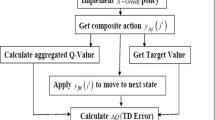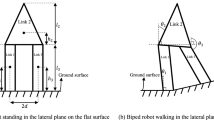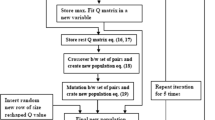Abstract
This paper contributes to the development of reinforcement fuzzy Q-learning incorporated with genetic kinematics analysis for self-organizing holonomic motion control of six-link Stewart platforms. The fuzzy theory is integrated with the Q-learning algorithm to develop a hybrid reinforcement learning strategy. Both the actions and the Q-functions in the classical Q-learning algorithm are inferred by means of fuzzy rules. The proposed hybrid reinforcement learning is then applied to self-organizing holonomic motion control of parallel Stewart platforms for industrial applications. After the kinematics analysis using a geometrical approach and genetic algorithm (GA)-based Newton–Raphson formulation, this study develops a practical control scheme that combines fuzzy Q-learning and proportional–integral–differential (PID) control scheme, called FQPID. In the proposed FQPID holonomic motion control method, the PID control gains are online-tuned via the fuzzy Q-learning computation process. An experimental Stewart platform consisting of six servo motors, adjustable links, and two platforms is constructed to illustrate the effectiveness of the presented methods. The experimental results are compared with some existing control methods using the same evaluation criterion. Through the experimental results and comparative works, the superiority of the proposed FQPID control scheme is presented and discussed.














Similar content being viewed by others
Explore related subjects
Discover the latest articles, news and stories from top researchers in related subjects.Data Availability
All data generated or analysed during this study are included in this published article.
References
He, Q., Zeng, C., Gao, Z., Wu, Z.: Analysis and design of the Stewart platform-based parallel support bumper for inertially stabilized platforms. IEEE Trans. Ind. Electron. 67(5), 4203–4215 (2020)
Stewart, D.: A platform with six degree of freedom. Proc. Inst. Mech. Eng. 180(15), 371–386 (1965)
Datta, S., Das, A., Gayen, R.K.: Kinematic analysis of Stewart platform using MATLAB. In: International Conference on Electronics, Materials Engineering & Nano-Technology (IEMENTech), pp. 1–4 (2021)
Cai, Y., Zheng, S., Liu, W., Qu, Z., Han, J.: Model analysis and modified control method of ship-mounted Stewart platforms for wave compensation. IEEE Access. 9, 4505–4517 (2021)
Ding, B., Cazzolato, B.S., Stanley, R.M., Grainger, S., Costi, J.J.: Stiffness analysis and control of a Stewart platform-based manipulator with decoupled sensor–actuator locations for ultrahigh accuracy positioning under large external loads. J. Dyn. Syst. Meas. Contr. 136(6), 1–12 (2014)
Wang, Y.: A direct numerical solution to forward kinematics of general Stewart–Gough platforms. Robotica 25(1), 121–128 (2007)
Kumar, P.R., Behera, A.K., Bandyopadhyay, B.: Robust finite-time tracking of Stewart platform: a super-twisting like observer-based forward kinematics solution. IEEE Trans. Industr. Electron. 64(5), 3776–3785 (2017)
Chen, S.H., Fu, L.C.: Output feedback sliding mode control for a Stewart platform with a nonlinear observer-based forward kinematics solution. IEEE Trans. Control Syst. Technol. 21(1), 176–185 (2013)
Ji, P., Wu, H.: A closed-form forward kinematics solution for 6–6p Stewart platform. IEEE Trans. Robot. Autom. 17(4), 522–526 (2001)
Phu, N.D., Ahmadian, N.N.: A new fuzzy PID control system based on fuzzy PID controller and fuzzy control process. Int. J. Fuzzy Syst. 22, 2163–2187 (2020)
Zhou, H., Chen, R., Zhou, S., Liu, Z.: Design and analysis of a drive system for a series manipulator based on orthogonal-fuzzy PID control. Electronics 8(1051), 1–15 (2019)
Li, R., Deng, S., Hu, Y.: Autonomous vehicle modeling and velocity control based on decomposed fuzzy PID. Int. J. Fuzzy Syst. 10, 1–9 (2022)
Hasanien, H.M.: Design optimization of PID controller in automatic voltage regulator system using Taguchi combined genetic algorithm method. IEEE Syst. J. 7(4), 825–831 (2013)
Sabahi, K., Hajizadeh, A., Tavan, A.: Adaptive type-2 fuzzy PID LFC for an interconnected power system considering input time-delay. Int. J. Fuzzy Syst. 23, 1042–1054 (2021)
Liu, G., Wang, Z., Zhao, G., Yan, R., Xu, Y., Wang, J., Pu, Y., Jiang, W.: Automatic hot test of gyrotron-traveling wave tubes by adaptive PID feedback control. IEEE Trans. Electron Devices 64(3), 1302–1306 (2017)
Rothmann, M., Porrmann, M.: A survey of domain-specific architectures for reinforcement learning. IEEE Access 10, 13753–13767 (2022)
Ma, Y., Chang, T., Fan, W.: A single-task and multi-decision evolutionary game model based on multi-agent reinforcement learning. J. Syst. Eng. Electron. 32(3), 642–657 (2021)
Jiandong, Z., Qiming, Y., Guoqing, S., Yi, L., Yong, W.: UAV cooperative air combat maneuver decision based on multi-agent reinforcement learning. J. Syst. Eng. Electron. 32(6), 1421–1438 (2021)
Watkins, C.J.: Learning from delayed rewards. Ph.D. dissertation, King’s College, Cambridge (1989)
Er, M.J., Deng, C.: Online tuning of fuzzy inference systems using dynamic fuzzy Q-learning. IEEE Trans. Syst. Man Cybern. B (Cybernetics) 34(3), 1478–1489 (2004)
Gheisarnejad, M., Sharifzadeh, M., Khooban, M., Al-Haddad, K.: Adaptive fuzzy Q-learning control design and application to grid-tied nine-level packed e-cell (PEC9) inverter. IEEE Trans. Ind. Electron. (2022). https://doi.org/10.1109/TIE.2022.3153803
Shi, H., Xu, M., Hwang, K.S.: A fuzzy adaptive approach to decoupled visual servoing for a wheeled mobile robot. IEEE Trans. Fuzzy Syst. 28(12), 3229–3243 (2020)
Wu, B.F., Chen, P.Y., Lin, C.H.: A new criterion of human comfort assessment for wheelchair robots by Q-learning based accompanist tracking fuzzy controller. Int. J. Fuzzy Syst. 18, 1039–1053 (2016)
Zhang, C.: Classification rule mining algorithm combining intuitionistic fuzzy rough sets and genetic algorithm. Int. J. Fuzzy Syst. 22, 1694–1715 (2020)
Engelbrecht, A.P.: Computational Intelligence: An Introduction, 2nd edn. Wiley, Hoboken (2007)
Acknowledgements
The authors are grateful to the anonymous reviewers for their constructive comments to improve the quality of this paper. This work is financially supported in part by the Ministry of Science and Technology, Taiwan, under the Grants MOST 109-2221-E-011-074, MOST 110-2221-E-011-121, MOST 111-2221-E-011-146-MY2, and MOST 111-2221-E-197-025.
Author information
Authors and Affiliations
Corresponding author
Rights and permissions
Springer Nature or its licensor (e.g. a society or other partner) holds exclusive rights to this article under a publishing agreement with the author(s) or other rightsholder(s); author self-archiving of the accepted manuscript version of this article is solely governed by the terms of such publishing agreement and applicable law.
About this article
Cite this article
Huang, HC., Xu, S.SD., Chen, YX. et al. Reinforcement Fuzzy Q-Learning Incorporated with Genetic Kinematics Analysis for Self-organizing Holonomic Motion Control of Six-Link Stewart Platforms. Int. J. Fuzzy Syst. 25, 1239–1255 (2023). https://doi.org/10.1007/s40815-022-01439-0
Received:
Revised:
Accepted:
Published:
Issue Date:
DOI: https://doi.org/10.1007/s40815-022-01439-0




